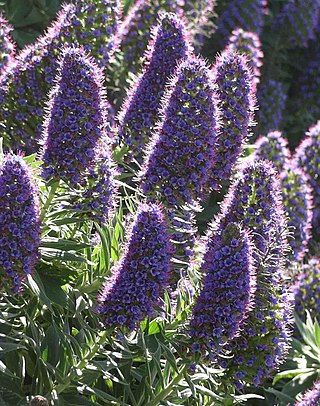
Argyrocytisus battandieri, the pineapple broom or Moroccan broom is a species of flowering plant in the legume family, Fabaceae, subfamily Faboideae. It is the only member of the genus Argyrocytisus.

Pinus canariensis, the Canary Island pine, is a species of gymnosperm in the conifer family Pinaceae. It is a large, evergreen tree, native and endemic to the outer Canary Islands of the Atlantic Ocean.

Genista stenopetala, the sweet broom, Easter broom or leafy broom, is a species of flowering plant in the legume family Fabaceae, native to the Canary Islands, on La Palma and Tenerife.

Genista monspessulana, commonly known as French broom, Montpellier broom, or Cape broom (Australia), is a woody leguminous perennial shrub. The yellow-flowering bush is native to the Mediterranean region, and while it may still be commonly sold in some garden stores, it is considered an invasive plant in most places where it has been introduced. It is a noxious weed on the western coast of the US and in parts of Australia.

Spartium junceum, known as Spanish broom, rush broom, or weaver's broom, it is a species of flowering plant in the family Fabaceae and the sole species in the genus Spartium. It is closely related to the other brooms.

Ulex europaeus, the gorse, common gorse, furze or whin, is a species of flowering plant in the family Fabaceae, native to Western Europe.

Phoenix canariensis, the Canary Island date palm or pineapple palm, is a species of flowering plant in the palm family Arecaceae, native to the Canary Islands off the coast of Northwestern Africa. It is a relative of Phoenix dactylifera, the true date palm. It is the natural symbol of the Canary Islands, together with the canary Serinus canaria. Mature P. canariensis are often used in ornamental landscaping and are collected and transplanted to their new planting location. A Canary Island date palm with 10 m (30 ft) of trunk is about 60 years of age.

Quercus canariensis, the Algerian oak, Mirbeck's oak or zean oak, is an oak native to southern Portugal, Spain, Tunisia, Algeria and Morocco. Despite the scientific name, it does not occur naturally today in the Canary Islands, though it may have in the past. It is placed in section Quercus.

Astrophytum ornatum, the bishop's cap or monk's hood cactus, is a flowering plant of the family Cactaceae, endemic to the Central Plateau of Mexico. It is the largest and tallest species of Astrophytum.

Echium candicans, the 'Pride of Madeira', is a species of flowering plant in the family Boraginaceae, and genus Echium, native to the island of Madeira. It is a large herbaceous perennial subshrub, growing to 1.5–2.5 m.

Genista tinctoria, the dyer's greenweed or dyer's broom, is a species of flowering plant in the family Fabaceae. Its other common names include dyer's whin, waxen woad and waxen wood. The Latin specific epithet tinctoria means "used as a dye".

Genista aetnensis, the Mount Etna broom, is a species of flowering plant in the legume family Fabaceae. It is a large shrub or small tree endemic to Sicily and Sardinia where it is associated with sunny, open landscapes and poor, stony soil. It is a very common constituent of the garigue plant communities, Mediterranean shrubby vegetation, around the lower slopes of Mount Etna, hence its Latin specific epithet aetnensis.

Cytisus striatus is a species of flowering plant in the legume family known by the common names hairy-fruited broom and Portuguese broom. This plant is native to the west of the Iberian Peninsula and northwestern Morocco.

Genista linifolia is a species of broom known by the common names Mediterranean broom, needle-leaved broom and flax broom. It is native to southwestern Europe, North Africa, and the Canary Islands.

Euphorbia canariensis, commonly known as the Canary Island spurge, Hercules club or in Spanish cardón, is a succulent member of the genus Euphorbia and family Euphorbiaceae endemic to the Canary Islands. It is the plant symbol of the island of Gran Canaria.

Deutzia gracilis, the slender deutzia or Japanese snow flower, is a species of flowering plant in the hydrangea family Hydrangeaceae, native to Japan.

Cytisus multiflorus is a species of legume known by the common names white broom, white spanishbroom and Portuguese broom.

Davallia canariensis, the hare's-foot fern, is a species of fern in the family Davalliaceae. It is endemic to Macaronesia and the Iberian Peninsula. It grows well in a sunny atmosphere and amongst rocks.

Cytisus nigricans, the black broom, is a species of flowering plant in the subfamily Faboideae of the family Fabaceae. Growing 3–5 ft (0.91–1.52 m) tall, it is a slender deciduous shrub with erect branches. Masses of brilliant yellow, slightly fragrant pea-like flowers appear in long racemes on the current year's growth in summer and early autumn.

Genisteae is a tribe of trees, shrubs and herbaceous plants in the subfamily Faboideae of the family Fabaceae. It includes a number of well-known plants including broom, lupine (lupin), gorse and laburnum.




















